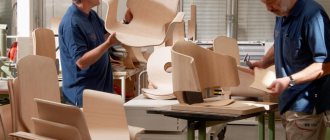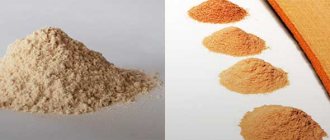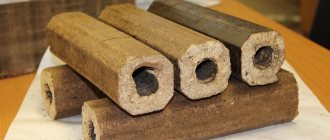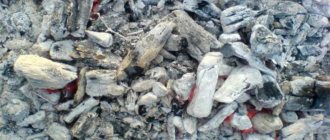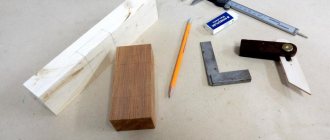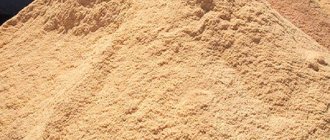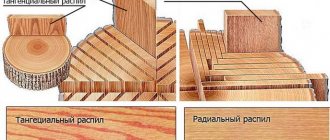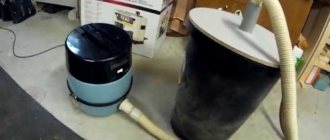- February 8, 2021
- Production
- Lika Lika
When wood is processed, a lot of shavings remain. In most cases, enterprises burn this waste, but the disposal of raw sawdust disrupts the environmental situation in the region. There is another way to use waste from wood processing companies. Sawdust processing as a business allows you to generate income at relatively low costs and ensure waste-free production.
Finished product - fuel briquettes
Fuel briquettes are a type of biofuel that is an alternative to coal and firewood. Briquettes are made from peat and wood waste, which are crushed, dried and pressed. This business idea is an excellent option for what can be made from sawdust.
This fuel has several advantages:
- Economical consumption. Compared to firewood, a briquette burns 3-4 times longer.
- Low amount of waste. After complete combustion, about 1% ash remains from such a product. Firewood produces 20% ash of the total mass.
- When using briquettes, heat is released evenly throughout the combustion. This distinguishes them from ordinary wood; when the latter burns, the amount of heat decreases as it burns.
- Minimum amount of odor and smoke.
- Convenient storage thanks to compact dimensions.
In Russia, such biofuel is used relatively rarely. Briquettes are in higher demand in European countries. This product is often called Eurofuel.
How to make briquettes?
The technological process used in production cannot be carried out at home. The reason is the lack of pressing or extrusion equipment capable of creating a pressure of at least 30 MPa. Without this, lignin cannot be isolated from wood and homemade briquettes will not be compressed. The solution is simple: you need to add a binder, which is ordinary clay. It is mixed with sawdust in a ratio of 1:10 by weight (1 kg of clay per 10 kg of waste), diluted with water and mixed thoroughly.
The resulting composition is filled into the mold and the mechanism is activated. If the production of fuel briquettes is done manually, then it is necessary to apply maximum force and hold the lever until the water runs out. Then the product is carefully removed and placed on an area in the open sun to dry. You can start filling out the form again and extruding the next “brick”.
Market analysis
Today, fuel briquettes in Russia are only gaining popularity. The first companies producing this type of product appeared in the early 2000s. In the first few years, about 30 enterprises opened, but only a few of them managed to expand production and reach the international level. Every year the number of European fuel producers increases.
The list of weaknesses of such a business includes:
- lack of experience and qualified specialists;
- some problems with the sale of finished products in large volumes.
Meanwhile, this industry has great potential. According to the Federal Energy Strategy, it is envisaged to create favorable investment conditions for those enterprises that are engaged in the production of renewable energy sources. The State Duma has a commission dedicated to the development of special projects in the field of alternative energy.
Why are briquettes good?
Fuel briquettes are crushed wood and wood waste, compressed into a form convenient for transportation and storage.
As a result of processing on machines by pressing under high pressure, the finished briquettes acquire new qualities. Their use instead of conventional firewood in stoves, fireplaces and wood-burning boilers provides the following advantages:
- increased combustion temperature and, accordingly, better heat transfer;
- a higher density of briquettes leads to longer burning of the same volume;
- reduced formation of soot and ash residues;
- Briquettes are produced in various shapes - short cylinders, rectangular bricks. But in any case, they are convenient for storage and carrying.
When compared with conventional firewood, Euro-firewood will not be worse in any respect. The disadvantages include the fact that by the appearance of the briquette it is not always possible to determine the specific wood from which it is made. And if, for example, birch briquettes are required, then you have to rely on the integrity of the manufacturer.
Production process
To produce briquettes or pellets from sawdust, you can use almost any waste from the woodworking industry. This could be slabs, shavings, trunks, lump waste or wane.
The entire production process can be divided into 2 main stages:
- Preparation. Sawdust or lump waste goes through a grinding stage in a chipper. As a result, it is possible to obtain chips with a fraction of 5-30 mm. After this, the raw materials are processed in a drying machine and the chips are re-crushed to a fraction size of 1 mm.
- Pressing. The crushed wood chips are driven through a sawdust screw press. In this installation, rectangular or cylindrical briquettes are formed using binders.
Blitz tips
- When making a homemade screw extruder, you should use only high-quality steel.
- It will not be possible to reproduce the process of producing briquettes with the release of lignin using homemade equipment , so it is recommended to add clay, cheap wallpaper glue or corrugated cardboard to the crushed raw materials. These components will be used as a binder.
- The simplest and most affordable are considered to be self-made devices equipped with a manual screw drive. The perforated form is filled with prepared sawdust mixed with a binder. Forming is carried out by tightening a screw. Such a press has one significant drawback - low productivity.
- Some craftsmen use a hydraulic jack to assemble a home press. It is worth noting that such a device is not capable of creating a pressure of even 300 Bar. A small amount of water and a binder added to the crushed raw materials will help improve the quality of briquettes.
- Crushed sawdust is used for the press, so the equipment should be supplemented with a rotary machine , on which the raw materials can be prepared for pressing. You can also make a shredder yourself from an old washing machine. To do this, it is enough to install knives instead of the activator.
Initial costs
As an initial cost, you will need equipment for sawdust processing. An entrepreneur can choose a ready-made production line or assemble it from individual devices. To produce Eurofuel you will need:
- crusher;
- dryer;
- conveyor line;
- storage bin for collecting raw materials;
- screw press for sawdust;
- heat generator;
- packaging technology;
- scales.
A finished production line for the production of fuel briquettes costs about 3-5 million rubles. The final cost depends on the performance and configuration of the devices. At the initial stage, experienced specialists advise choosing a line in the middle price range with average performance indicators. In this case, it is better to give preference to those production lines that can subsequently be modernized (for example, adding a second press). Cheap units have low productivity, which limits the volume of output per hour.
For transportation, installation and maintenance of purchased equipment, about 1-1.5 million rubles will be required.
Another important expense item is the renovation of the premises and the installation of a ventilation system. On average, the cost reaches 3.5 thousand rubles. for 1 sq. m.
Moving raw materials and finished products around the workshop, as well as loading and unloading, requires special equipment - a loader. Its cost reaches 800-900 thousand rubles. To save money, you can buy used special equipment.
For the office you will need:
- 2 tables for workers;
- rack for storing documentation;
- chairs;
- computer;
- stationery.
On average, office equipment will require about 500 thousand rubles.
Before launching the line, it is also necessary to purchase raw materials. The costs will be about 500 thousand rubles.
The design is made on the basis of a hydraulic installation
Step-by-step instructions for making a press
- To make the base, you need to connect the parts from the channel by welding.
- Cut 4 pieces 1.5 m long from the corners (they are used as stands). Weld them to the base at the same distance from each other (vertical location).
- Fix a drum made from a large diameter pipe to the corners. If such a pipe is not at hand, you can make the mixer body from a sheet of tin. To increase productivity, it is equipped with an electric motor.
- A box for filling raw materials is made from sheet iron. It is recommended to make the body shape in the form of a cone for spontaneous loading movement when filling the trays.
- The gearbox is fixed to the bottom of the cone-shaped body and a tray for the output product is welded.
- In a thick-walled pipe, make holes at intervals of 3-5 mm. When pressure is applied to the mass, air and water will escape through the holes. Weld a flange to the bottom of the workpiece that will hold the removable bottom. The bottom is made of a sheet of steel in the form of a circle with eyes.
- Weld the matrix to the base under the cone-shaped body.
- Cut a disk from a steel sheet of a size that would allow free movement in the matrix. It performs the function of a punch.
- Weld the prepared pipe for the rod to the punch. The other edge is attached to the hydraulic unit.
- The assembled unit is mounted on racks directly above the matrix.
- The receiving tray is installed in such a way that it does not interfere with the process of shooting and fixing the matrix bottom.
Pre-drying will be provided by heating elements installed around the perimeter of the machine. The briquettes will be ready for final preparation in an open area with low air humidity.
According to the technological process, raw materials need to be prepared before processing, which means a dryer and a grinding device are required
Selecting a room
To start sawdust processing as a business, you will need a spacious room with an area of at least 120 square meters. m. The building must have:
- a large workshop in which the production line will be installed;
- storage space for sawdust and finished products;
- equipped office;
- bathroom
To start the equipment, access to a 380 V (100 kW) power supply is required.
If the building is owned by an entrepreneur, then utility bills should be taken into account. About 70-100 thousand rubles are paid monthly for renting a workshop.
Types of briquettes
Eurofirewood differs both in appearance and composition. Eco-friendly firewood is created in three types of standard shapes.
By shape
Depending on the shape and pressure of the press with which they were made.
Briquettes RUF
Rectangular "RUF". To compress them, hydraulic presses with a pressure of 350 to 400 bar are used. The rectangular shape of the briquettes, reminiscent of a brick, simplifies their transportation and long-term storage.
Briquettes Nestro
Cylindrical "NESTRO". When forming them, shock-mechanical and hydraulic presses are used, in which the pressure reaches 600 bar. Such fuel pellets have low moisture resistance.
Briquettes Pini&Kay
Multifaceted (extruded) “Pini&Kay”. This species is distinguished by radial holes in the center and a characteristic dark color; are manufactured at high temperatures up to 200-300 C and mechanical press pressure up to 1100 bar. They are characterized by high resistance to moisture and mechanical stress.
- Woody. The raw materials for them are all waste from processing wood products: shavings, chips, sawdust, bark, slabs.
- From agricultural waste. Cereal husks, corn and sunflower waste, peat, charcoal - all this turns into raw materials for European firewood. They do not have such high heat transfer as other types.
- Coal. Briquettes made from coal dust are the best in terms of heat transfer.
Capital expenditures
Capital costs are generally understood to be those expenses that are necessary to start an enterprise. These are one-time expenses.
| Expenses | Sum |
| Purchase of equipment for fuel production, installation, launch | 5,000,000 rub. |
| Purchase of a forklift | 900,000 rub. |
| Office equipment | 500,000 rub. |
| Repair of office and workshop, ventilation, electrical installation, additional costs | 1,000,000 rub. |
| General capital expenditure | RUB 7,400,000 |
Purchase of raw materials
To launch a sawdust processing line, you need to select raw materials. It is important to consider consumption. To make 1 cu. m of briquettes you need 4 cubic meters. m sawdust. On average, this volume contains 1.2 tons.
The cost of sawdust varies depending on the region and reaches 600-800 rubles. for 1 cubic m.
To reduce production costs, you should look for better offers in the region. Some furniture factories and other woodworking companies have difficulty selling waste, so they offer to pick up shavings for free. In this case, costs are only necessary to rent a truck for transportation. Even a small part of the raw materials received for free will speed up the payback of the project.
Basic elements of the press
The main elements of an ordinary press are a mold (a glass into which the bulk substance is placed), a piston and a pressure-creating mechanism. It is not difficult to make them yourself, as they are typical for briquetting machines.
Mold device
The glass into which sawdust or shavings are poured is called a mold or chamber. The parameters of the briquette will depend on its geometry.
Whatever the cross-sectional shape of the glass will be, this will be the type of briquette. But its length can be very different, but definitely not exceeding the height of the molds
Typically the chamber is constructed from scraps of round or shaped steel pipe. The base of the piston, which enters the glass, is cut out of a thick-walled (at least 3 mm thick) plate.
When making a mold, you need to take into account the ratio of the following quantities:
- cross-sectional area of the mold (s, cm2);
- applied pressure to the piston (u, kgf);
- specific pressure on raw materials (p, kgf/cm2).
These quantities are related by the relation:
p=u/s
Briquettes using an additional binder hold their shape well if they are formed at a specific pressure of more than 150 atm. (1 atm. ≈ 1 kgf/cm2). Based on the possibility of the force generated by the piston, the cross-sectional area of the chamber is calculated.
For example, if there is a 10 ton hydraulic jack, then:
s < u / p = 10000 / 150 = 67 cm2.
For such conditions, a profile square pipe with a side length of 80 mm or a round pipe with a nominal diameter of up to 90 mm is suitable.
The length of the resulting briquette (l) depends on the height of the mold (h), the density of the raw material in the initial dry (q1) and briquetted (q2) state:
l = h * (q1 / q2)
In addition, after the first compression, you can pour the chips into the glass again and repeat the procedure. In this way, you can bring the length of the resulting product almost to the height of the pressing chamber.
During the compression of sawdust, moisture is released from the briquette. In order for it to come out freely, the chamber is perforated with small but frequently spaced holes.
You can ensure the outflow of water from the chamber through holes that are made using a 2-3 mm metal drill
After the briquette is formed, it must be removed from the mold. Using a spring and a false bottom, as is often recommended on the Internet, is impractical. High pressure completely compresses the spring, so over time its shape becomes distorted, causing it to lose its properties.
Therefore, you need to either make a detachable bottom of the mold and push out the briquette, or build a collapsible cup. In the second case, you will need to make an additional shirt for him from a rod.
Available methods of creating pressure
There are three common ways to achieve pressure that are well suited for a homemade fuel briquette press: using a lever, a hydraulic jack or a screw. Each of them is good in its own way, and their implementation in practice is not very difficult.
Use of muscular strength and leverage
Usually a metal pipe is used as a lever. It should not bend under the influence of human muscular strength. For example, a reinforced water pipe with a diameter of 40 or 50 mm with a wall thickness of 4 - 4.5 mm is suitable.
Formula for calculating the piston pressure force (m) depending on the force applied by a person (M), the distance from the piston to the lever attachment point (l) and its total length (L)
The length of the lever and the distance from the fulcrum to the connection with the piston are chosen not only based on achieving the desired pressure. Another important parameter is the depth of immersion of the piston into the glass (h, cm).
It is calculated using the formula:
h = R * (l / L)
Here R (cm) is the height to which the end of the lever will fall.
It is advisable to make the structure in such a way that the depth of immersion of the piston is sufficient to form a briquette without repeated compression with preliminary addition of material. This will greatly increase the production rate.
The required immersion depth of the piston (h, cm) can be calculated knowing the initial dry (q1) and briquetted (q2) density of the raw material and the height of the glass (H):
h = H * (1 – q1 / q2)
If for some reason an error occurs (usually due to incorrect determination of the initial density of the raw material) and the depth of immersion of the piston is not enough to impart the required hardness to the product, then it is not necessary to digest the entire structure.
You can either reduce the height of the glass, or, adding sawdust, press one briquette in two or three passes.
Application of hydraulic jack
To create strong pressure, hydraulic devices are used, such as the usual bottle jacks. As a rule, in a household where there is a car or other equipment, such hydraulic units are available, but their carrying capacity may be insufficient.
The design of a typical hydraulic press consists of a frame and a movable beam on which a jack is placed. The system returns to its original position due to the action of springs
Jacks are inexpensive. Thus, models designed for 30-40 tons can be purchased for less than 5 thousand rubles. And with such indicators it is already possible to obtain briquettes of large cross-section or several (3-5) copies of regular size at once.
To produce several briquettes at the same time, the required number of molds are placed in a row. The middle moving frame must be strong so that it does not bend over time. It is best made from an I-beam or thick-walled profile pipe.
The pressing process itself takes longer than when using a lever design. However, the use of a powerful hydraulic jack allows one to achieve much greater specific pressure on the workpiece. The briquettes are more even and dense and already have an attractive presentation.
Screw pressing mechanism
The operating principle of a manual screw press is similar to a lever press, only the applied force is transmitted at an angle of 90°. The larger the handle diameter and the smaller the thread pitch, the greater the pressure increase factor.
A sawdust screw press is similar to a juice extractor. However, the pressure created in it is much greater. Therefore, the strength of the threaded mechanism should be higher
This design also allows for greater pressure to be generated than a lever-based machine. Its significant disadvantage is the slowest operating speed among the presented options.
However, the advantages include:
- simplicity of design;
- the opportunity to buy such a press for little money with minor modifications for briquetting needs;
- small size.
When working with a screw press, you should not use it “all the way”, when physical strength is no longer enough to turn the mechanism. In this case, the force applied by a person acts on the thread on one side, and on the other (at 90°) is the resistance force of the resulting briquette. This will lead to rapid thread wear or breakage.
In order not to overdo it and not break the mechanism, you need to achieve a sufficient result on test copies and either install a retainer or make a mark on the thread with a marker, marking its maximum allowable position.
Staff
To process sawdust into fuel briquettes, a small staff will be required at first. The head of the company is the founder of the company.
Minimum number of employees:
- process engineer (salary from 25 thousand rubles);
- mechanic for servicing special equipment (25 thousand rubles per month);
- accountant manager (25 thousand rubles);
- 4 workers (salary 20 thousand rubles).
Taxes
When opening a company that produces sawdust briquettes, you need to pay attention to the way of doing business. This will affect the tax features and capabilities of the company.
Experts advise registering an LLC - this legal form means a limited liability company. This type of business will allow the company to cooperate with both individuals and legal entities. Thanks to this, the scope of sales of finished products will expand significantly.
According to the requirements, the company owner will have to pay several types of taxes:
- VAT - 18%;
- on the amount of profit - 20% (here the amount of profit received by the company is taken into account);
- income tax - 13%;
- on property - 2.2% (tax is paid taking into account the value of the purchased property);
- social payment - 34%.
Briquette manufacturing technology
The process of producing heating material is labor-intensive and requires sequential operations.
If necessary, you need to prepare the raw materials before use:
- Crushing of material;
- Drying of crushed raw materials;
- Grinding (the better the components of the briquettes are crushed, the higher the heat transfer rates).
To make it yourself, the raw materials need to be mixed with a binder. Clay in accordance with 1 to 10 is quite suitable for this, where 1 kg of clay and 10 kg of crushed material are taken
The resulting mixture must be mixed with water to form a homogeneous mass, it is important that it is neither liquid nor solid
The resulting mass must be loaded into special equipment. During pressing, excess liquid is released and the product receives its final shape. If you use a homemade press, there is a possibility that a small amount of moisture will still remain inside the product.
An obligatory point in the manufacture of heating material is drying after pressing. You can dry it outdoors, in the sun and wind. The time of this stage depends on the volume of briquettes, as well as on the pressing technologies used.
After drying, the product must be moved to a special storage place or packaged.
Monthly expenses
The company owner should first calculate the monthly costs. Before opening a company, you need to have in reserve an amount equal to 2-3 monthly payments. The fact is that for some time the company will set up production, look for points of sale for its products and increase its turnover. The founder should prepare for temporary financial difficulties.
| Expenses | Sum |
| Purchase of raw materials (sawdust mulch) | Cost of 1 cubic. m of sawdust is 500-700 rubles. |
| Salary to employees | 155,000 rub. |
| Renting premises | 70,000 rub. |
| Taxes VAT | from 50,000 rub. |
| Income tax | about 50,000 rub. |
| Monthly loan payment | about 150,000 rub. |
| Other expenses (including advertising) | about 100,000 |
| Total monthly expenses | about 575,000 + purchase of raw materials |
Enterprise productivity and revenue
To calculate the income of a company producing sawdust briquettes, it is necessary to take into account several indicators:
- enterprise productivity (volume of finished products produced per day);
- cost of goods sold.
As an example, we can consider a small company that employs 4 workers in 2 shifts. Each shift lasts 8 hours with a lunch break.
If the equipment productivity reaches 0.8 t/h (average), then about 11 tons of briquettes will be produced per shift. With 25 working days per month, the volume will be about 270-280 tons.
If we take into account that the wholesale cost of 1 ton of fuel costs 5,000 rubles, then the sale of products will bring the company 1 million 350 thousand rubles per month.
Homemade press
If you have a drawing and certain design skills, you can make a press for fuel briquettes with your own hands.
There are two types of homemade devices for briquetting - those operating from a jack and those with a manual drive.
A description of the assembly of the structure will help you understand how to make a press and which option is best to use.
Manual
To make a hand press, you need a punch. It is constructed from thick metal sheet. A pressure lever is attached to the material, and the structure is secured using hinges.
The punch is installed in a special form. Usually it is made square. The mold is made from metal. Using a thin drill, holes are drilled in the bottom and sides to allow moisture to escape during the pressing process.
To collect the released water, a container is used in which the finished press is installed.
From the jack
To obtain higher quality solid fuel and improve the design of the press, a hydraulic jack is used.
The manufacturing process of such equipment consists of the following stages:
1. The base for the press is formed from the channels. All metal parts are fastened by welding.
2. Racks are attached to each corner of the prepared base in a vertical position. Each support is taken 1.5 meters high.
3. The mixer is welded to the stands. The drum can be made from a pipe with a large diameter or take a ready-made part from an old washing machine.
4. A galvanized steel tray is fixed under the mixer, from which the raw materials will penetrate into a special mold.
5. Holes are created in the thick-walled pipe intended for the matrix. They should be evenly distributed throughout the circular contraction. The width of each opening should be from 3 to 5 millimeters.
6. At the bottom of the mold, a flange is fixed using a welding machine, to which the bottom is screwed.
7. The finished form is connected to the base.
8. After this, a punch is cut from steel sheets. It should have the same shape as the matrix. Using a rod, the punch is connected to a hydraulic element.
The assembled mechanism is fixed on top of the form to the racks. The tray is fixed at the bottom.
To speed up the process of removing pressed briquettes, it is recommended to weld the disk and spring to the bottom of the matrix. It must match the diameter of the punch. This mechanism will allow you to automatically push out finished products after turning off the hydraulics.
Pressed wood raw materials require drying. The lower the moisture content of the briquettes, the better they burn. In addition, dry briquettes have higher heat transfer.
Self-made compact fuel can significantly reduce the cost of heating your home. Ready-made briquettes can be used both for the boiler and for the stove. But it should be borne in mind that the quality of the product largely depends on the density indicator.
It is almost impossible to make compressed firewood using homemade equipment that will burn for a long time and give off a large amount of heat.
Therefore, if you need to use fuel with high performance, it is better to purchase it in specialized stores.
Marketing and advertising
In order for sawdust processing as a business to generate good income, a properly structured advertising campaign is required. To promote finished products on the commodity market, it is important to ensure regular sales.
As part of an advertising campaign, you can follow several steps:
- Ordering a commercial or text message on radio and television.
- Print advertisements in local newspapers.
- Creation of a business card website. In this case, the company increases the chances of interregional and international transactions.
- Maintaining pages on social networks. Such an advertising move will expand the circle of clients.
To increase sales volume, you will need to think through various promotions and volume discounts. Launching an advertising campaign will require about 100 thousand rubles.
Possible risks
When studying the profitability of a sawdust business, do not forget about some possible risks:
- Relatively high costs to open and run a business.
- Search for buyers. Today, European fuel is not yet in widespread demand among Russians.
- Lack of highly qualified workers.
- Relatively high competition in this production segment. Every year, companies specializing in the production of sawdust pellets are opened throughout the country.
- There is a seasonal change in demand. This problem can be solved by concluding an agreement for the wholesale supply of biofuel to enterprises. The price in this case will be lower, but uninterrupted supplies will be required - the company will not be idle.
Payback period
Experts cannot provide precise data on this issue. This is explained by the influence of several indicators at once (costs, productivity, cost of finished products). On average, you can cover all the costs of opening a production facility and turn a profit in 24-30 months. However, for such indicators it is important to reduce the cost of the finished product, purchase a productive crusher, dryer and press for sawdust, as well as the uninterrupted sale of briquettes.
Do it yourself
The high cost of equipment does not always justify the cost of purchasing it, so craftsmen implement their designs to create homemade presses. It is worth noting that making a screw device is quite difficult, so not everyone undertakes this type of pressing.
At home, it is almost impossible to achieve the required level of pressure that would ensure the release of lignin. But it is quite possible to build hydraulic units and granulators with your own hands.
All homemade devices are divided into three main types:
- The sawdust briquetting technology itself is quite interesting and has its advantages, so owners do not deny themselves the desire to acquire a home press
from jacks;
- with manual drive;
- with hydraulic drive.
The sawdust briquetting technology itself is quite interesting and has its advantages, so owners do not deny themselves the desire to acquire a home press.
Thanks to the use of briquettes, it is possible to prevent the formation of debris near the firebox of a stove or boiler, as well as to eliminate frequent loading. The location of home-made units can be wall-mounted or floor-mounted, depending on how convenient it is for you.
Before you begin assembling the press, you need to take into account all stages of the production process to ensure drying and grinding of raw materials. It is also worth taking care of a utility room or shed for storing finished products.
To assemble a hydraulic press, you will need to prepare the following materials and tools:
- metal sheet 4-6 mm;
- corner 100x100 mm;
- channel;
- a pipe with thick walls (the diameter is determined by the size of the briquettes at the outlet);
- pipe 25-30 mm for making a punch rod;
- galvanized steel for forming trays;
- large pipe or sheet of metal for making the mixer body;
- welding machine and electrodes;
- grinder with discs;
- drill;
- hammer;
- measuring devices, etc.
Production of pellets and briquettes as a business expansion
The production of biofuel can be considered not only as an independent business, but also as an expansion of an existing one. Many furniture factories, construction companies and other woodworking enterprises are wondering what can be made from sawdust.
The idea of producing fuel briquettes will allow for maximum optimization of production. The amount of waste will tend to zero. This will eliminate the need for disposal.
Another advantage of business expansion is that pellets and briquettes will become another way of income with minimal investment. In this case, the founder will not have to purchase raw materials for fuel. This will ensure a quick return on costs associated with renting a workshop and purchasing specialized equipment.
How to make a press for fuel briquettes yourself
A factory press for the production of fuel briquettes, which can operate according to one of the above-described schemes, is quite expensive, so it is advisable to purchase such equipment only if you plan to produce fuel on an industrial scale. In order to produce heating briquettes for your own needs, you can make a homemade press using one of the design diagrams of such a device, which are easy to find on the Internet.
Drawings of a press for making briquettes (click to enlarge)
A homemade briquetting press can be made entirely from scratch or a ready-made mechanism capable of creating significant pressure can be used as the basis for such equipment. Regardless of the design scheme used to make a homemade briquetting machine, one should take into account the fact that such a device will not be able to create pressure sufficient to separate lignin from sawdust. It is for this reason that when using a homemade press to make briquettes, binders are added to the sawdust mass before pressing, which can be used as:
- inexpensive wallpaper glue;
- clay, which is added to the sawdust mass in a ratio of 1:10;
- pre-soaked paper or corrugated cardboard, which contains lignin, which exhibits its adhesive properties upon contact with water.
The peculiarity of making briquettes using a homemade design is also that the sawdust mixture is not dried before pressing, but soaked, which promotes better gluing of the particles that make up such a mixture. Ready-made briquettes are dried in the open air using a homemade sawdust press.
Making a device from scratch
In order to make a press for the production of fuel briquettes practically from scratch, you can take as a basis a screw (or lever) mechanism, with the help of which such a device will create the required pressure. To make such a manual press, you don’t even have to look for drawings; you just need to complete a technical drawing, focusing on the dimensions of the mechanism used.
Homemade lever press
The matrix of a homemade press can be round or rectangular in shape
The principle of operation of a screw (or lever) press is as follows: the raw materials for the production of fuel briquettes are placed in a perforated container, which, after filling, is installed under the frame of the device. The pressure that such a mechanical press provides is created by the rotation of a screw or the movement of a lever, depending on the design features. A manual lever-type briquetting machine is more productive and convenient to use, since in it the form in which the fuel briquette is formed is released from the finished product much easier.
Homemade briquetting devices of lever and screw type are distinguished by their simple design, but cannot boast of high productivity. It is advisable to use a mechanical mini-press for briquettes, made on the basis of a screw or lever mechanism, for the periodic production of Euro firewood in small quantities.
Manufacturing a briquetting machine based on a ready-made power mechanism
A more powerful, productive and easy-to-use briquetting machine (or briquetting press) can be made on the basis of a ready-made power mechanism, which can be a hydraulic jack or a small hydraulic press. To convert such a power unit into a briquette press, it must be equipped with a punch and a matrix, which will ensure the formation of a fuel briquette from sawdust mixed with a binder composition.
The design features that distinguish a briquetting press made on the basis of a hydraulic jack or another type of power mechanism are as follows.
- The hydraulic drive mechanism is connected to a punch, the dimensions of which must correspond to the dimensions of the matrix. In the cavity of the latter, the formation of a fuel briquette from sawdust mass is carried out.
- To make a matrix, in the walls of which holes are drilled to allow air and moisture to escape, you can use a thick-walled pipe.
- The matrix of a homemade press is equipped with a removable bottom, when removing which the finished briquette is simply pushed out of its internal cavity with a punch.
Operating principle of a homemade press based on a hydraulic jack
To make a hydraulic press for the production of fuel briquettes, in addition to the power mechanism and a thick-walled pipe for the matrix, the following consumables will be required:
- metal channel;
- equal angle angle No. 100;
- a metal sheet 3–6 mm thick, from which the punch and removable bottom for the matrix will be made (the thickness of such a sheet is selected depending on the diameter of the matrix: the larger this parameter, the thicker the sheet should be);
- a pipe with a diameter of 25–30 mm from which the punch rod will be made;
- a large-diameter pipe, which is necessary to make the mixer body (if a pipe of a suitable diameter is not available, then you can equip a homemade briquetting press with a mixer, the body of which is made of a sheet of tin);
- sheets of galvanized steel (from which the trays of a homemade briquette press will be made), one of which is used to load feedstock into the cavity of the matrix, and the second is used to receive finished fuel briquettes.
The internal diameter of the thick-walled pipe from which the matrix of the homemade briquetting machine will be made is selected depending on the cross-sectional size of the briquettes that are planned to be made on such a device. When choosing this parameter, you should keep in mind: the smaller the diameter of the briquettes, the higher their density will be, but at the same time the hydraulic press will work with low productivity.
Welding the frame of a homemade press
A homemade press for the production of briquettes, the basis of which is a jack or other hydraulic-type power mechanism, is assembled in the following sequence:
- The base of the device is welded from pre-cut sections of channel.
- 4 vertical posts are welded to the resulting base of the homemade press, for the manufacture of which sections of a corner, each 1.5 meters long, are used.
- A drum is made from a large diameter pipe or sheet of tin in which the sawdust mass will be mixed. To make such a drum, you can use a tank from an old washing machine.
- The drum for mixing sawdust is mounted on the racks of a homemade press (if possible, it should be equipped with a drive consisting of an electric motor and a belt drive).
- The tray through which the prepared mixture will be fed into the matrix cavity is fixed directly under the mixing drum.
- Several holes with a diameter of 3–5 mm are drilled into the walls of a thick-walled pipe, which will act as a matrix for a homemade briquetting machine. Through them, air and excess moisture will escape from the sawdust mass during the process of squeezing it with a punch. When making such holes, they should be placed evenly along the entire height of the matrix.
- A flange is welded to the lower end of the matrix of a homemade briquette press, to which a removable bottom will be screwed, which is a circle made of a metal sheet with lugs welded to it.
- The matrix is welded or screwed to the base of the press directly under the loading tray.
- A metal circle is used as a punch with which a homemade briquetting machine will apply pressure to the sawdust mass. Such a circle is cut out of sheet metal. A punch made in this way must have a diameter that allows it to be easily removed from the cavity of the press matrix. To make a rod, one end of which is welded to the punch, and the other is connected to the working body of the hydraulic power mechanism, you can use a pipe with a diameter of 25–30 mm.
- The last thing you should do to ensure that your homemade briquetting press is ready for use is to secure the punch to the stands, positioning it exactly above the die cavity.
Press assembly process
Homemade high-performance press
Many home craftsmen are wondering how to make a mechanical impact or screw press for briquettes with their own hands, which are characterized by higher productivity than the briquetting press of the design described above. In this case, the following must be taken into account: in order to manufacture a screw press, the use of special metalworking equipment and quite expensive materials will be required, which can negate the whole point of such a labor-intensive undertaking.
Press with electric motor
To understand the structure of the press, it is better to look at a detailed overview of the factory machine.
